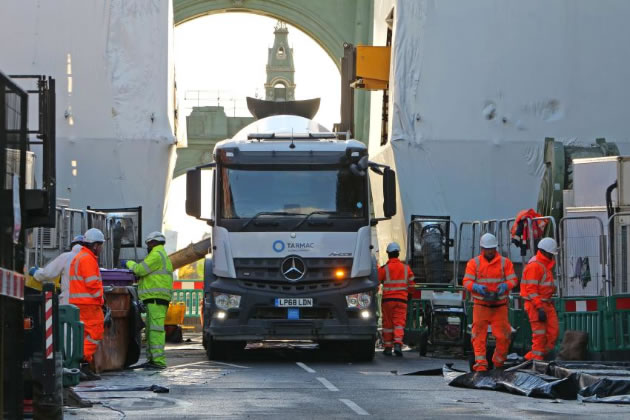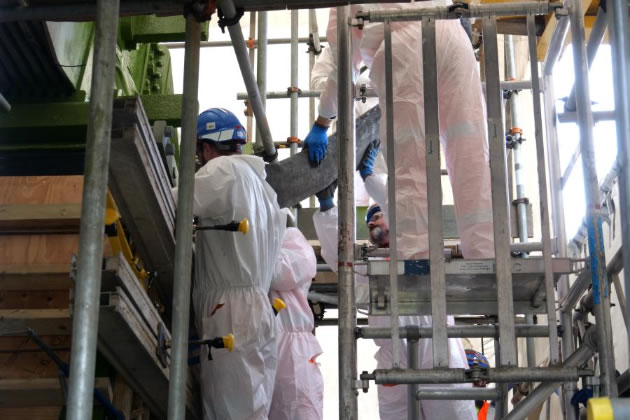Important Step Forward for Hammersmith Bridge Repair
Four pedestals strengthened by bespoke concrete

The concrete being poured into the pedestals on Hammersmith Bridge. Picture: HF Council
The prolonged project to bring Hammersmith Bridge back into full service has made an important step forward earlier this month.
The 135-year-old Hammersmith Bridge was further stabilised after engineers successfully strengthened all four pedestals using bespoke concrete.
The team of engineers leading the project described this as critical work which required meticulously planning and trials off-site using a replica pedestal.
This has allowed the pedestals containing micro-fractures on the bridge to be reinforced with the unique concrete mix.
The four cast iron pedestals, one on each corner of the bridge, bear the weight of the structure which, because of its unique design, is one of the most expensive bridges in the country to repair.
The engineers have maintained the Grade II* listed pedestals’ appearance by pouring concrete inside their hollow centres which added to the difficult of the task because it had never been attempted before.
Concrete normally reaches a higher temperature when it sets. However, the cast iron pedestals are vulnerable to the stresses that heat causes, so engineers used a special low carbon material to keep the concrete’s curing heat low.
The concrete also had to be able to flow strongly enough to get into the pedestals’ 19th-century nooks and crannies, while maintaining its strength.
Engineers included ‘super-plasticisers’ into the concrete mix to ensure it flowed well, and small steel fibres made the concrete stronger.
Concrete normally has to be shaken or poked in order to ‘compact’ and set into the desired shape. Due to the fragility of the fractured pedestals, this was not an option.
The engineers have instead used ‘self-compacting’ concrete which sets with its own weight.
The concrete mix was tested on-site to ensure the correct fibre content and flowability before 40 tonnes of it was successfully poured into the pedestals to stabilise them for further works.

Engineers monitor the pouring of the concrete into a pedestal. Picture: HF Council
The next step for the pedestals is to inject grout into the top of each and attach temporary steel plates. This will provide extra support for the pedestals.
Then, steel reinforcements will be mounted to the points, or saddles, where the bridge’s chains are attached.
The steel shipment was delayed by the Ukraine War but it has now arrived at the fabrication factory in the north east of England, where it is being cut welded and machined into shape.
Finally, the team will jack the saddles up and replace the corroded seized bearings.
Earlier this month Hammersmith & Fulham Council agreed further plans for the full restoration of the bridge which includes advancing a proposal for a temporary double decker structure to allow it to open for motor traffic sooner than expected.
According to the Hammersmith Society, before work on installing the double decker structure can begin a gas main needs to be diverted and this is believed to be a major project.
Like Reading Articles Like This? Help Us Produce More This site remains committed to providing local community news and public interest journalism. Articles such as the one above are integral to what we do. We aim to feature as much as possible on local societies, charities based in the area, fundraising efforts by residents, community-based initiatives and even helping people find missing pets. We’ve always done that and won’t be changing, in fact we’d like to do more. However, the readership that these stories generates is often below that needed to cover the cost of producing them. Our financial resources are limited and the local media environment is intensely competitive so there is a constraint on what we can do. We are therefore asking our readers to consider offering financial support to these efforts. Any money given will help support community and public interest news and the expansion of our coverage in this area. A suggested monthly payment is £8 but we would be grateful for any amount for instance if you think this site offers the equivalent value of a subscription to a daily printed newspaper you may wish to consider £20 per month. If neither of these amounts is suitable for you then contact info@neighbournet.com and we can set up an alternative. All payments are made through a secure web site. One-off donations are also appreciated. Choose The Amount You Wish To Contribute. If you do support us in this way we’d be interested to hear what kind of articles you would like to see more of on the site – send your suggestions to the editor. For businesses we offer the chance to be a corporate sponsor of community content on the site. For £30 plus VAT per month you will be the designated sponsor of at least one article a month with your logo appearing if supplied. If there is a specific community group or initiative you’d like to support we can make sure your sponsorship is featured on related content for a one off payment of £50 plus VAT. All payments are made through a secure web site. |
November 8, 2022